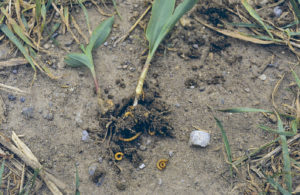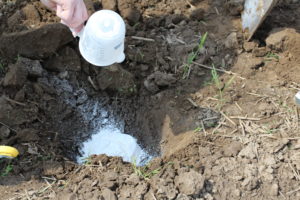
Now is a great time to scout for wireworms and grubs. With the recent warm weather, soil temperatures have reached 10oC, which means that wireworm baits will be most effective right now and grubs will also be feeding close the soil surface. How much time there is to scout for these pests depends on how quickly the soil warms up and dries down. Too warm and dry and the baits won’t work as well and the pests may have moved down deeper in the soil. But typically, the best time to scout in the spring is from now until late May.
Pest assessment report that are completed this spring can be used for this fall seed order. After August 31, 2016, if growers want to buy any amount of neonicotinoid treated corn or soybean seed for the 2017 growing season, they will need to complete a pest assessment for every 100 acre or less areas that are under one municipal roll number. If one field is larger than 100 acres, then it needs to be divided into two separate plots.
Soil Inspection Pest Assessment – For every 100 acre or less plot, baits or digging will need to be conducted in 5 areas of the field. Look for higher risk areas of the fields to focus your scouting efforts, though each of the 5 scouting areas need to be 10 metres apart from each other. High risk areas of the field include sandy or silty areas of the field, especially knolls, areas where grassy weeds are prevalent, or in areas where gaps in the stand have been noticed in the past.
 To set up wireworm baits:
To set up wireworm baits:
- Dig a hole approx 15 cm by 15 cm by 15 cm deep
- Place a cup of bait in the bottom of the hole. Baits can be made of:
- 1 cup of all-purpose flour – moisten with some water once placed in the hole or
- 1 cup of equal parts of untreated corn, wheat and beans that has been soaked overnight.
- Break up any clumps of soil that was dug up and mound the soil over the bait.
- To deter predators and keep the bait moist and warm, place a black plastic bag over the bait station and cover the corners of the plastic with soil so that it doesn’t blow away.
- Place a flag at the station so you can find it again.
- Return 7 to 10 days later to dig up the bait. Break up the bait to search for the presence of wireworms.
Do this for at least 5 locations in the plot, each bait station being at least 10 metres apart from each other. Experience has taught us that predators like to pull up the baits so place more than is required to ensure that there are five still left to assess.
To dig for wireworms or grubs:
- Dig a hole approximately 30 cm by 30 cm wide to about 7 to 10 cm deep.
- Sift through the soil that was removed from the hole, breaking up any larger clumps.
- Search and record any wireworms or grubs found in the hole or the soil that was removed.
Do this digging method for at least 5 locations in the plot, each location being at least 10 metres apart from each other.
Remember, don’t confuse millipedes for wireworms. Click here to see the differences.
The threshold to purchase and use (plant) neonicotinoid treated corn or soybean seed is an average of 1 wireworm or 2 grubs averaged over 5 scouting locations. If this threshold is met, fill out the Inspection of Soil – Pest Assessment Report.
Additional Resources:
OMAFRA Wireworm and Grub Scouting Videos
Guide to Early Season Field Crop Pests
Pest Manager app: Android iPhone, iPad
Integrated Pest Management Course for Corn and Soybeans Manual
Neonicotinoid Regulations for Ontario Corn and Soybean Growers